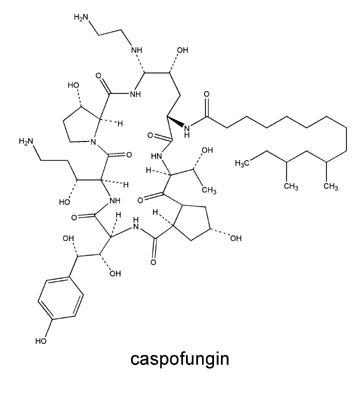Manufacturer’s Prescribing Information
Trade & Generic Names & General Features
Formerly L-743,872 and MK-0991, caspofungin is a polypeptide antifungal related to pneumocandin B0. It is a glucan synthesis inhibitor of the echinocandin structural class. It is manufactured by Merck Research Laboratories and its trade name is Cancidas™.

Mechanism(s) of Action
Caspofungin blocks the synthesis of a major fungal cell wall component, 1-3-beta-D-glucan. Although some authorities suggest that the inhibition of glucan synthesis occurs via inhibition of 1,3-beta-glucan synthase [1267], there is yet no evidence to prove this theory. The lack of glucan synthesis enzymes in mammalian tissue makes this an attractive target for antifungal activity [566].
Caspofungin is fungicidal for Candida spp. [195, 683, 1631, 1780]. MIC rank order by species is Candida albicans = C. tropicalis = C. glabrata <= C. parapsilosis < C. krusei = C. lusitaniae [1432, 2299]. It has no activity against Cryptococcus neoformans [195, 759].
Caspofungin is active against Aspergillus spp. [1780]. This activity can be observed by using a distinctive parameter, “minimum effective concentration” (MEC) [120, 1269]. For details and current knowledge available for the method, see susceptibility testing and N/A(L):susceptibility database.Caspofungin exerts antifungal activity at actively growing tips and branching points of Aspergillus hyphae, leading to formation of flattening and swelling tips. MEC is the lowest concentration of the drug yielding this appearence microscopically [612].
Activity of caspofungin against isolates Trichosporon beigelii, Fusarium spp., and Rhizopus arrhizus is limited. Data on fungi other than those listed are less described and variable [558, 683]. For caspofungin MICs obtained for various types of fungi, see susceptibility patterns and the N/A(L):susceptibility database.
Usual Doses
Doses of 35-70 mg/day have been applied in trials already reported [111, 1995]. The recommended dose of caspofungin in invasive aspergillosis is a single loading dose of 70 mg on day 1, followed by 50 mg daily then on. The duration of therapy depends on the severity of the infection, immune status of the host, and clinical response.
Side-Effects
Minimal side effects have been observed. Infusion may cause histamine release [111, 1995].
Routes
Caspofungin has intravenous formulation. It should be administered by slow infusion over approximately one hour.
Current Status
Clinical use of caspofungin was licensed in USA in January 2001. Caspofungin is indicated as salvage therapy in cases with invasive aspergillosis [1406] who have been refractory or intolerant to amphotericin B, lipid amphotericin B formulations, and/or itraconazole. Caspofungin has also proven to be effective in treatment of oropharyngeal and esophageal candidiasis in adults [Arathoon, 2002 10957][111, 595, 1995, 2325, 2326], including disease due to fluconazole-resistance isolates [1155]. Caspofungin has been shown active in invasive candidiasis: In a randomized comparative study, caspofungin (70 mg loading dose then 50 mg/d in adults) was effective but better tolerated than amphotericin B deoxycholate (0.6-1.0 mg/kg/d) for invasive candidiasis (83% candidemia, 10% peritonitis, and 7% miscellaneous forms) [1572].
Caspofungin (70/50) was also shown to be as effective as liposomal amphotericin B (3 mg/kg) as empiric therapy in febrile neutropenic patients In a large, randomized blinded study of over 1095 patients (556 receiving caspofungin and 539 receiving liposomal amphotericin B) the overall success rates were 33.9 percent for caspofungin and 33.7 percent for liposomal amphotericin B (95.2 percent confidence interval for the difference, -5.6 to 6.0 percent), fulfilling statistical criteria for the noninferiority of caspofungin. [Walsh et al. New Eng J Med 2004;351:1391]
